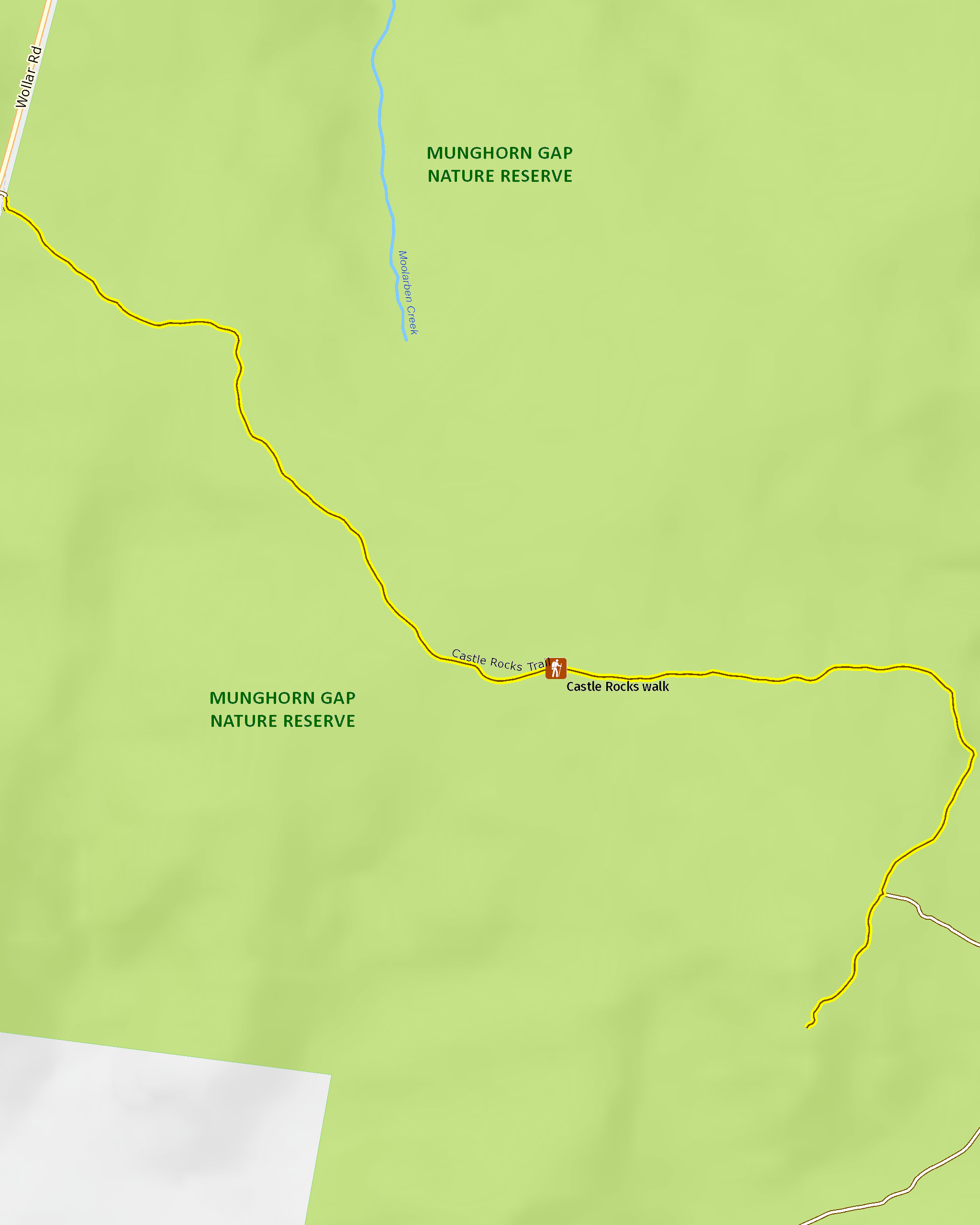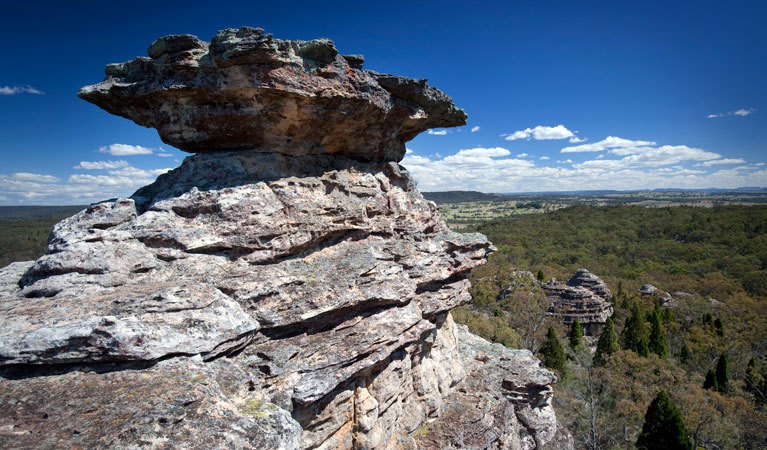Overview
It’s an easy hike along Castle Rocks walk to the lookout for wonderful scenic views of the sandstone pagoda features found at Munghorn Gap Nature Reserve.
- Where
- Munghorn Gap Nature Reserve in Country NSW
- Distance
- 8.5km return
- Time suggested
- 3 - 5hrs
- Grade
- Grade 3
- What to
bring - Drinking water, hat, sunscreen
- Please note
- Remember to take your binoculars if you want to birdwatch
- You'll need to bring your own drinking water
- Sections of this reserve are isolated, so please ensure you’re well-prepared, bring appropriate clothing and equipment and advise a family or friend of your travel plans.
- There is limited mobile reception in this park
Hiking Castle Rocks walk has its rewards. Not only will you be breathing in the fresh air of Munghorn Gap and getting fit, but superb scenic views await you when you reach the end. From the lookout, you’ll see some of the amazing sandstone pagoda features found throughout the park.
As you follow this walking route, you’ll notice that the eucalypt and native pine bushland around you is teeming with birdlife. See how many different types you can spot while birdwatching during your hike. Also, remember to look carefully in the trees and on the ground for signs of nests, which are as varied as the birds themselves. Some even live in tree trunks, in the hole left behind when an old branch drops off.
Map

Map legend

Local alerts
For the latest updates on fires, closures and other alerts in this area, see https://www.nationalparks.nsw.gov.au/things-to-do/walking-tracks/castle-rocks-walk/local-alerts
General enquiries
- National Parks Contact Centre
- 7am to 7pm daily
- 1300 072 757 (13000 PARKS) for the cost of a local call within Australia excluding mobiles
- parks.info@environment.nsw.gov.au
Park info
- in Munghorn Gap Nature Reserve in the Country NSW region
Munghorn Gap Nature Reserve is always open but may have to close at times due to poor weather or fire danger.
Visitor info
All the practical information you need to know about Castle Rocks walk.
Track grading
Features of this track
Distance
8.5km return
Time
3 - 5hrs
Quality of markings
Clearly sign posted
Experience required
Some bushwalking experience recommended
Gradient
Short steep hills
Steps
Occasional steps
Quality of path
Formed track, some obstacles
Getting there and parking
Get driving directions
On entering Munghorn Gap Nature Reserve:
- Park at Castle Rocks walk trackhead
Parking
Parking is available at Castle Rocks walk trackhead.
Best times to visit
There are lots of great things waiting for you in Munghorn Gap Nature Reserve. Here are some of the highlights.
Spring
The heathland begins flowering in late winter and it really starts to hit its stride in early spring. This makes it a particularly great time for camping, birdwatching and hiking.
Weather, temperature and rainfall
Summer temperature
Average
16°C and 30°C
Highest recorded
43°C
Winter temperature
Average
3°C and 16°C
Lowest recorded
-7.2°C
Rainfall
Wettest month
January
Driest month
April
The area’s highest recorded rainfall in one day
134.3mm
Maps and downloads
Prohibited
Pets
Pets and domestic animals (other than certified assistance animals) are not permitted. Find out which regional parks allow dog walking and see the pets in parks policy for more information.
Smoking
NSW national parks are no smoking areas.
Learn more
Castle Rocks walk is in Munghorn Gap Nature Reserve. Here are just some of the reasons why this park is special:
Back and forth

After Europeans settled in the region, Munghorn Gap became a route for horse and bullock teams connecting Wollar, Merriwa and Mudgee. Evidence of past blacksmithing, timber-cutting, peat and coal mining, prospecting, and quarrying can still be found in and around the reserve.
Birds of a feather

As far as birdwatchers are concerned, Munghorn Gap is a happening place to go twitching. Over 164 different species of birds inhabit the reserve either permanently or seasonally, and many of these are rare and uncommon. They come in all shapes and sizes, from Australia's tallest bird, the emu, to the country's smallest, the 8-9cm weebill. Many are brightly coloured, such as rare scarlet honeyeaters and flame robins, while others like jackie winters and tree martins are more subdued in appearance. Bowerbirds and lyrebirds can be seen in Munghorn Gap along with national favourites like kookaburras, magpies and galahs. Birds of prey include wedge-tailed eagles, whistling kites, collared sparrowhawks, peregrine falcons and brown goshawks. After dark the boobook and owls - powerful, barking, and barn -take over for the nightly hunt.
- Castle Rocks walk It’s an easy hike along Castle Rocks walk to the lookout for wonderful scenic views of the sandstone pagoda features found at Munghorn Gap Nature Reserve.
- Moolarben picnic area Moolarben picnic area, at Munghorn Gap Nature Reserve, is a great place to picnic, barbecue and relax. Enjoy light hiking? Castle Rocks walk is close by.
Let's get physical

Great Dividing Range stretches the length of Eastern Australia and creates an interface between the western plains and the mountains. Munghorn Gap is one of the lowest points of the range and lies on the extreme western edge of the Sydney-Bowen geological basin. Parts of the reserve drain into Cudgegong River and, in turn, the Macquarie River system.
- Castle Rocks walk It’s an easy hike along Castle Rocks walk to the lookout for wonderful scenic views of the sandstone pagoda features found at Munghorn Gap Nature Reserve.
Trading places

Munghorn Gap has been inhabited by Aboriginal people for over 12,000 years. Once a major trading route between the Blue Mountains and the plains, Munghorn Gap continues to be a significant place to local Wiradjuri people.

